New data from the Middle Jurassic of China shed light on the phylogeny and origin of the proboscis in the Mesopsychidae (Insecta: Mecoptera)
- PMID: 26727998
- PMCID: PMC4700641
- DOI: 10.1186/s12862-015-0575-y
New data from the Middle Jurassic of China shed light on the phylogeny and origin of the proboscis in the Mesopsychidae (Insecta: Mecoptera)
Abstract
Background: The Mesopsychidae is an extinct family of Mecoptera, comprising eleven described genera from Upper Permian to Lower Cretaceous deposits. In 2009, several well-preserved mesopsychids with long proboscides were reported from the mid Mesozoic of Northeastern China, suggesting the presence of pollination mutualisms with gymnosperm plants and highlighting their elevated genus-level diversity. Since that time, additional mesopsychid taxa have been described. However, the phylogeny of genera within Mesopsychidae has not been studied formally, attributable to the limited number of well-preserved fossils.
Results: Here, we describe two new species, Lichnomesopsyche prochorista sp. nov. and Vitimopsyche pristina sp. nov. and revise the diagnosis of Lichnomesopsyche daohugouensis Ren, Labandeira and Shih, 2010, based on ten specimens from the latest Middle Jurassic Jiulongshan Formation of Inner Mongolia, China. After compiling data from these new fossil species and previously reported representative taxa, we conducted phylogenetic analyses and geometric morphometric studies that now shed light on the taxonomy and phylogeny of Mesopsychidae. We also evaluate the recurring origin of the siphonate proboscis in the Mecoptera and propose an evolutionary developmental model for its multiple origins.
Conclusions: Phylogenetic and geometric morphometric results confirm the establishment of two new species, each to Lichnomesopsyche and Vitimopsyche. Vitimopsyche pristina sp. nov. extends the existence of the genus Vitimopsyche Novokshonov and Sukacheva, 2001, from the mid Lower Cretaceous to the latest Middle Jurassic. Two methods of analyses indicate an affiliation of Mesopsyche dobrokhotovae Novokshonov, 1997 with Permopsyche Bashkuev, 2011. A phylogenetic analysis of the Mesopsychidae supports: 1), Mesopsychidae as a monophyletic group; 2), Mesopsyche as a paraphyletic group, to be revised pending future examination of additional material; and 3), the independent origin of the proboscis in the Pseudopolycentropodidae, its subsequent loss in earliest Mesopsychidae such as Epicharmesopsyche, its re-origination in the common ancestor (or perhaps independently) in the Vitimopsyche and Lichnomesopsyche clades of the Mesopsychidae. The third conclusion indicates that the proboscis originated four or five times within early Mecoptera, whose origin is explained by an evolutionary developmental model.
Figures

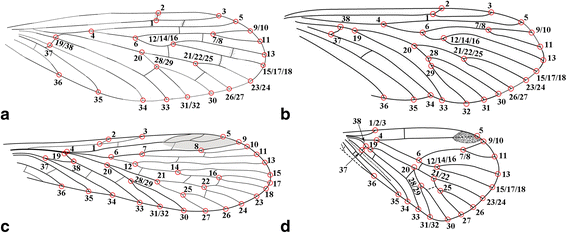

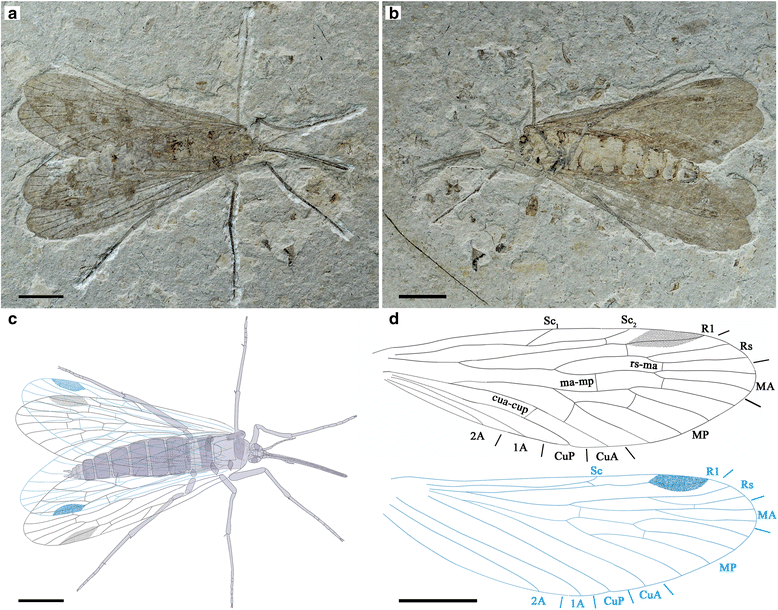
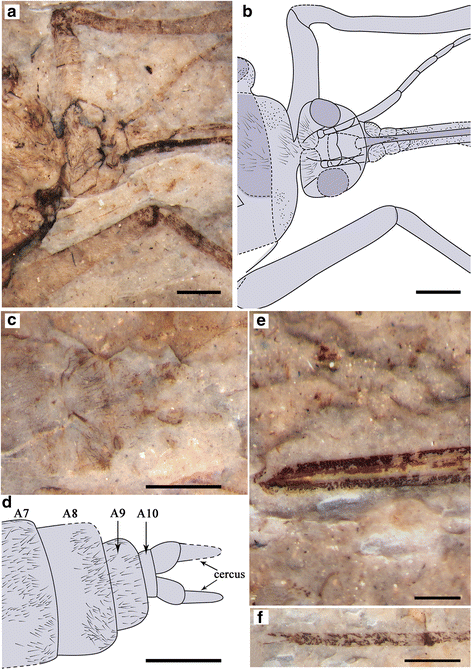

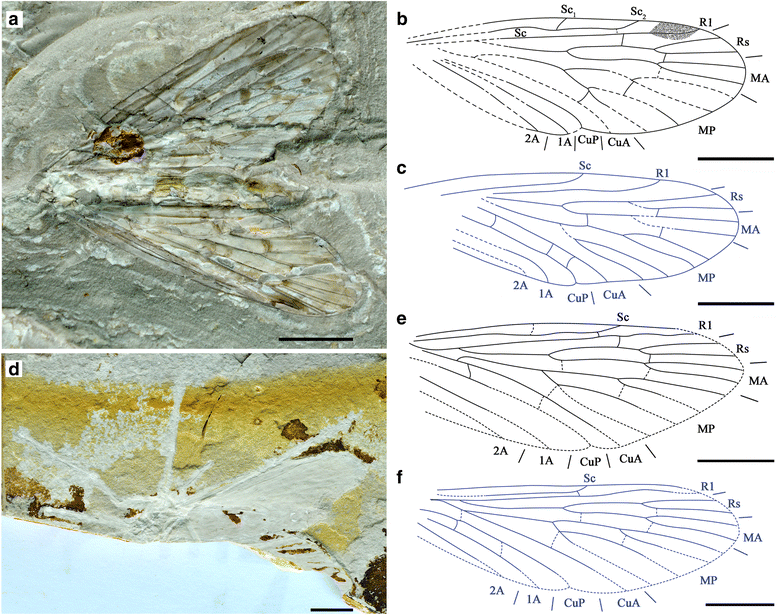


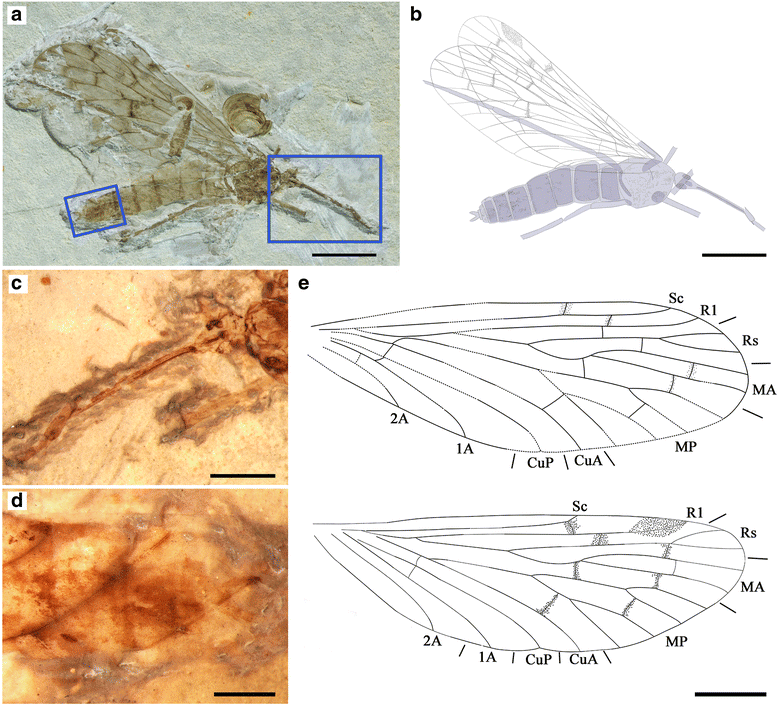



Similar articles
-
New species of Mesopsyche Tillyard, 1917 (Mecoptera: Mesopsychidae) from the Triassic of northwestern China.Zootaxa. 2021 Jul 1;4995(3):565-572. doi: 10.11646/zootaxa.4995.3.10. Zootaxa. 2021. PMID: 34810550
-
The earliest Mesopsychidae and revision of the family Mesopanorpodidae (Mecoptera).Zookeys. 2011;(130):263-79. doi: 10.3897/zookeys.130.1611. Epub 2011 Sep 24. Zookeys. 2011. PMID: 22259282 Free PMC article.
-
Mesozoic lacewings from China provide phylogenetic insight into evolution of the Kalligrammatidae (Neuroptera).BMC Evol Biol. 2014 Jun 9;14:126. doi: 10.1186/1471-2148-14-126. BMC Evol Biol. 2014. PMID: 24912379 Free PMC article.
-
Behaviors and Interactions of Insects in Mid-Mesozoic Ecosystems of Northeastern China.Annu Rev Entomol. 2021 Jan 7;66:337-354. doi: 10.1146/annurev-ento-072720-095043. Epub 2020 Sep 11. Annu Rev Entomol. 2021. PMID: 32916066 Review.
-
A new fossil from the Jurassic of Patagonia reveals the early basicranial evolution and the origins of Crocodyliformes.Biol Rev Camb Philos Soc. 2013 Nov;88(4):862-72. doi: 10.1111/brv.12030. Epub 2013 Feb 28. Biol Rev Camb Philos Soc. 2013. PMID: 23445256 Review.
Cited by
-
Jurassic scorpionflies (Mecoptera) with swollen first metatarsal segments suggesting sexual dimorphism.BMC Ecol Evol. 2021 Mar 20;21(1):47. doi: 10.1186/s12862-021-01771-3. BMC Ecol Evol. 2021. PMID: 33743581 Free PMC article.
-
Life habits and evolutionary biology of new two-winged long-proboscid scorpionflies from mid-Cretaceous Myanmar amber.Nat Commun. 2019 Mar 15;10(1):1235. doi: 10.1038/s41467-019-09236-4. Nat Commun. 2019. PMID: 30874563 Free PMC article.
-
Recombination, truncation and horizontal transfer shape the diversity of cytoplasmic incompatibility patterns.bioRxiv [Preprint]. 2025 Jan 6:2025.01.06.631454. doi: 10.1101/2025.01.06.631454. bioRxiv. 2025. Update in: Mol Biol Evol. 2025 Aug 12:msaf200. doi: 10.1093/molbev/msaf200. PMID: 39829853 Free PMC article. Updated. Preprint.
-
Two new species of Itaphlebia (Insecta, Mecoptera, Nannochoristidae) from the late Middle Jurassic of China.Zookeys. 2022 Jun 24;1108:175-188. doi: 10.3897/zookeys.1108.85378. eCollection 2022. Zookeys. 2022. PMID: 36760696 Free PMC article.
-
Fiddler Crabs (Crustacea: Decapoda: Ocypodidae) From Coastal Ecuador and the Galápagos Islands: Species Descriptions and DNA Barcodes.Ecol Evol. 2025 Jan 27;15(1):e70646. doi: 10.1002/ece3.70646. eCollection 2025 Jan. Ecol Evol. 2025. PMID: 39872901 Free PMC article.
References
-
- Proctor M, Yeo P, Lack A. The natural history of pollination. Portland: Timber Press; 1996.
-
- Krzemiński W, Soszyńska MA. A new genus and species of scorpionfly (Mecoptera) from Baltic amber, with an unusually developed postnatal organ. Syst Entomol. 2012;37:223–228. doi: 10.1111/j.1365-3113.2011.00602.x. - DOI
Publication types
MeSH terms
LinkOut - more resources
Full Text Sources
Other Literature Sources

